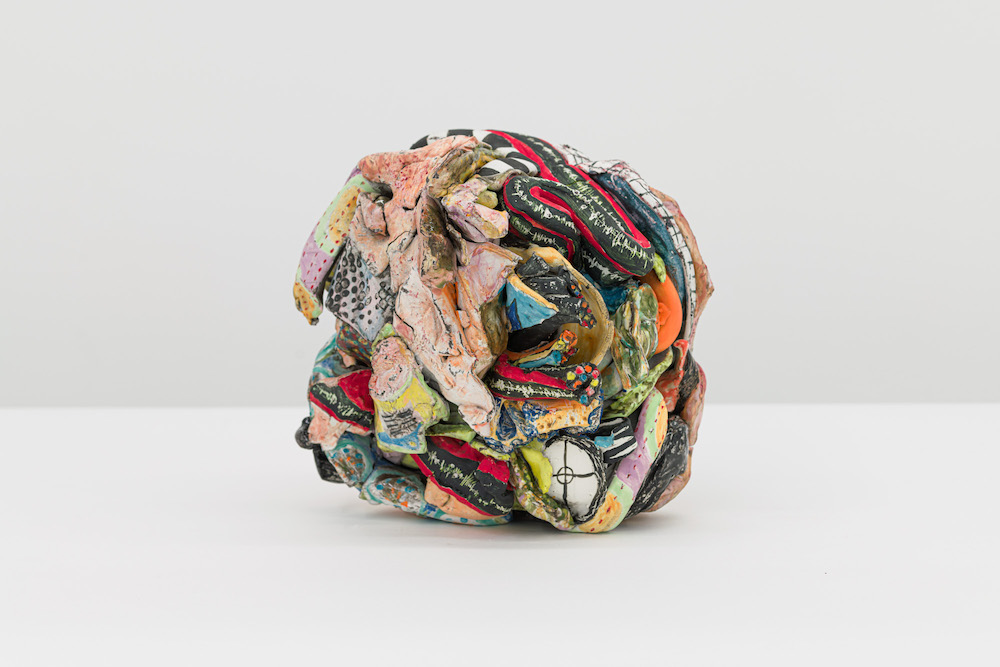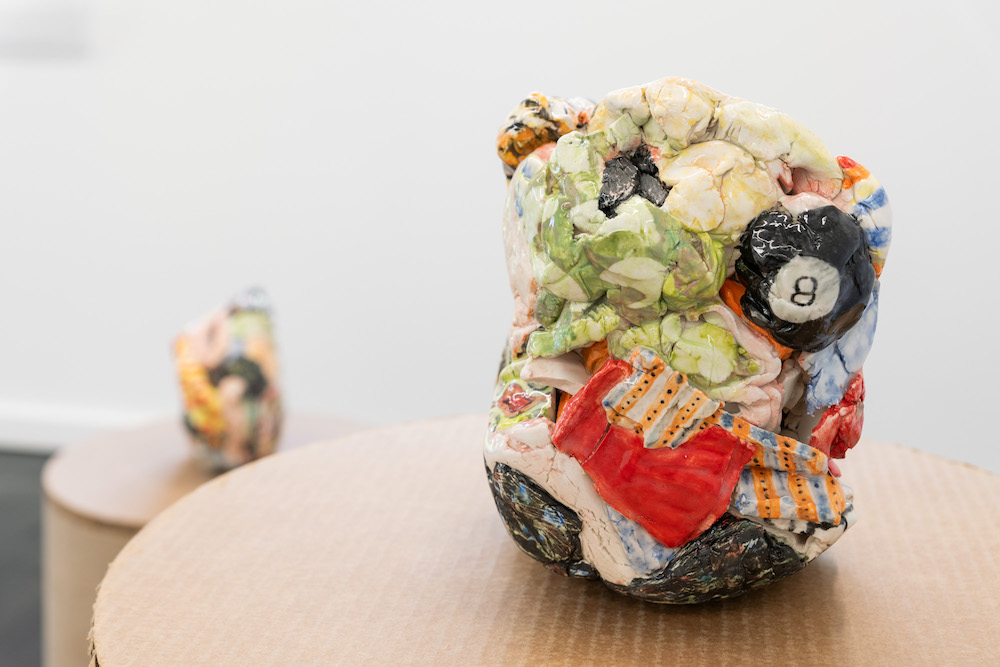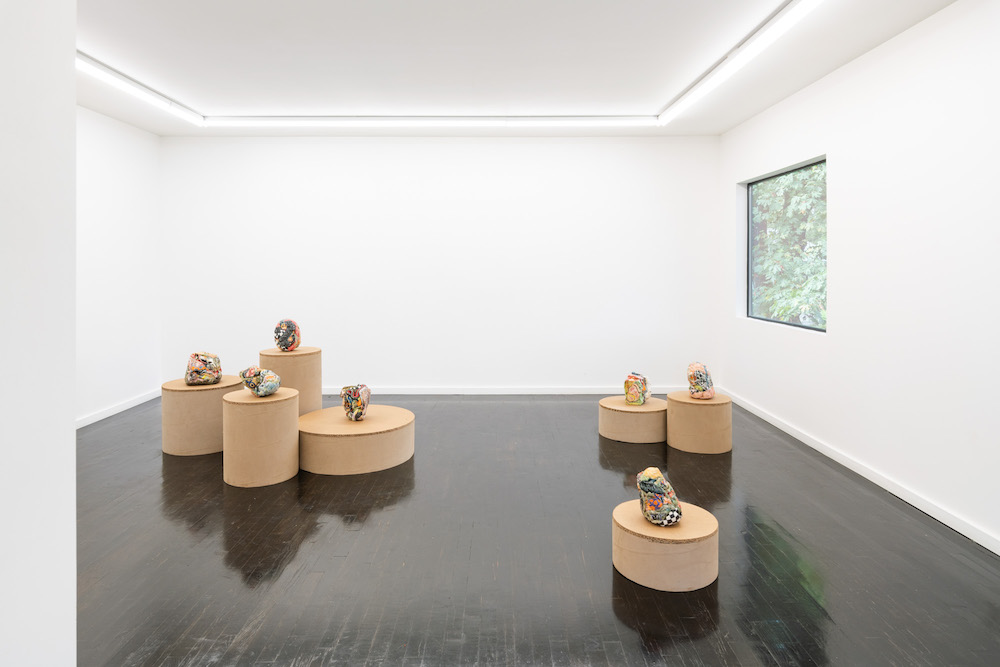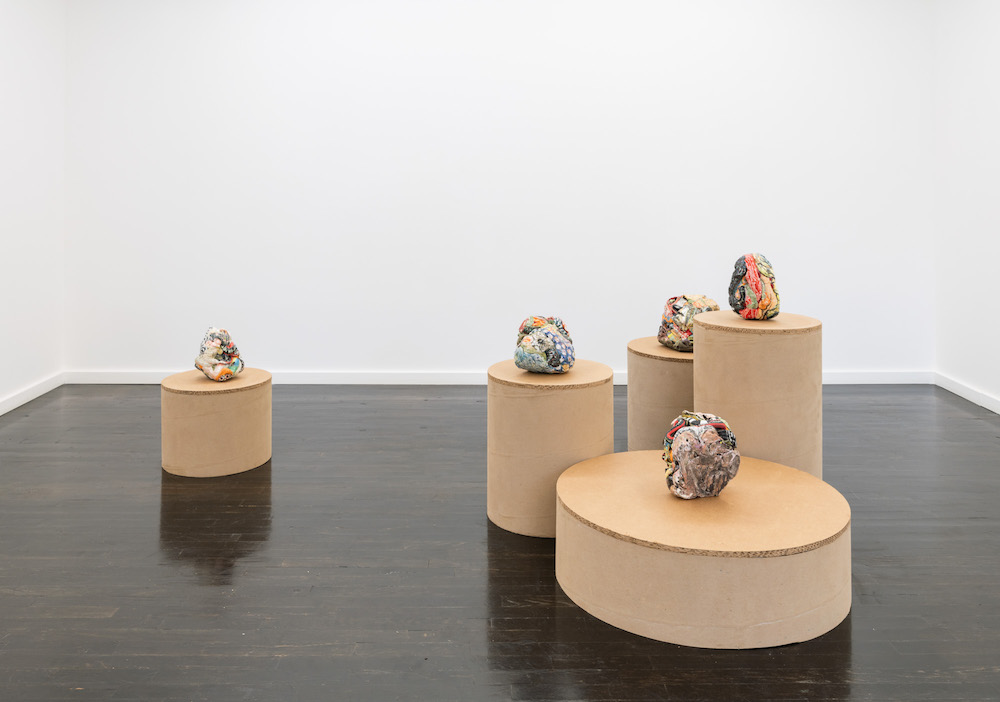They are dense forms, knots of entwined ropes and masses of clay, approximately the size of one of the larger internal organs. This suite of recent ceramic sculptures by Emily Ginsburg is presented on clusters of columnar plinths of corrugated cardboard that would be read as strictly utilitarian but for the very precisely cut thick corrugated tops. There is something in these plinth tops, the robustness of the corrugated structure capable of supporting these clearly heavy masses, that speaks to that which underlies the works, the materiality of the material, its provenance, and the labor required to extract, process and produce it.
That which holds up the work might be the subtextual theme of “Metabolic,” a solo exhibition of works by Emily Ginsburg at SE Cooper Contemporary in Portland, Oregon.
It’s important to further describe the way the ropes and faces that are folded into the totalizing forms are each glazed in a separate color or pattern. These often rectilinear patterns assert on the crumpled, textured surfaces an artificial visual logic in tension with the flowing bulges of the composite forms. It’s a playful mashup of patterns, many of which appear to be drawn from textiles—checks, stripes, chevrons—in a visual language produced the world over by warp and weft of looms of various kinds. But there are also dots, leaves, and painted figures that exceed the boundaries of the clay patchworks that could be read as arterial or as geologic cross-sections or aerial views. The thinness of the glaze on the non-patterned areas of the objects makes the multicolored patchwork less of a riot and more of a taxonomy, invoking the small, casual tiles of glaze firing tests. There are, as well, a notable few areas of clay painted as representations of objects such as a circuit board, an iPhone, a Magic 8-ball. These “objects” lend a John Chamberlain-esque aspect to the pieces, as though a hand basket full of consumer objects (and a clutch of snapshots of patterns) had been put into a trash compactor.

Emily Ginsburg, “Metabolic,” installation view. Courtesy of SE Cooper Contemporary.
And trash is not far off. Ginsburg has produced these works with the off-cuts of previous ceramic works, bags of clay waste from a clay production studio that have the potential to be reprocessed into useable clay through a laborious process, but are regularly discarded. She took each bag of clay scraps and let it dry over a long period of time before bisque firing. Some of the scraps in each cluster still bear traces of hand and fingerprints from previous use.
These blobby forms and their cavalcade of glazes recall works that Glenn Adamson in 2009 deemed “sloppy craft.” In a moment that a number of visual artists had begun using traditional craft media such as clay while deliberately eschewing traditional craft techniques, “sloppy craft” captured both ethos and the resulting object.
In the mid-2000s many words were spilled about the status of craft vis-a-vis art as it tried to have it both ways: to insist on designating itself as a special category of aesthetic object and labor grounded in technique and to be taken seriously as contemporary art. However, in contemporary art, valorization or privileging of technique had been as retrograde a position since the readymade as medium-specificity had been since the dawn of postmodernism.
A decade and a half later, Ginsburg’s move of making sculptures that are concretions of unmanipulated cast-offs of traditional craft labor, the bags of ceramic trash, rejects, offcuts, excesses of production, invites a broader discussion.

Courtesy of SE Cooper Contemporary.
It has been more than 100 years since Marcel Duchamp’s ceramic work, The Fountain, introduced nomination as a new category of immaterial or cognitive artistic labor while this first readymade simultaneously indexed anonymous productive labor. In one move that art historians have been re-theorizing ever since, he negated manual technique as a value in art AND made visible within art the labor that the commodity obfuscates. It’s commonplace now to understand that readymade as making visible or drawing attention to this anonymous productive labor in plain sight.
It’s perhaps only slightly less common to note that all art objects are, and all artistic labor, is beholden to the same productive labor. No painter mines and processes her own pigments and mixes them into some medium to produce paint. No painter grows cotton, harvests, processes it and weaves her own canvases. The clay discards that Ginsburg employs were not dug from the ground by the hand of the ceramic artists who used them.
Ginsburg’s sculptures, these clumps of detritus, empirically index the productive labor of the workers in the production clay studio who previously handled this clay. Ginsburg’s glazing interventions represent a slice of the range of unproductive, autonomous labor special to an artist, labor that is not in service of capital, not producing profit for another.
Art production, though a special category of labor noted by theorists such as John Roberts, is not completely divorced from the exploitative labor practices of capital. Ginsburg’s works also point out that art production is also constituted by extractive (mineral and clay mining) and waste-producing practices wreaking destructive havoc on our ecosystems as much as any other form of production.

Courtesy of SE Cooper Contemporary.
Metabolic. As nature would digest the unfired clay back into dust, to sediment, to clay and/or rock again, so capitalism digests the time and life and person of the laborer as well as the raw materials of the world into its myriad products: commodities packaged, labeled, shipped, and slapped on to shelves.
There is a degree to which the artist cannot help but metabolize the thousand daily visual inputs of the built environment, of commodity, of ubiquitous marketing, of mass media, of social media. Ginsburg, however, seems to reproduce cultural inputs quite directly, juxtaposing patterns and colors in a loose and chaotic manner. The directness of her operation, in fact, refuses any metabolism toward the production of a synthetic coherence instead maintaining pattern and color in stubborn suspension.
It is as if a thousand eyes trawled across days and nights of images, sometimes isolating patterns, and jumbling them up into a collective mental refuse pile like that on the ship deck of one of the garbage trawlers at the gyre of churning debris particles known as the Great Pacific Garbage Patch.

Courtesy of SE Cooper Contemporary.
Nearly 40 years after Frederic Jameson sketched the outlines of conditions of postmodernism in “The Cultural Logic of Late Capitalism,” it is this essay that may suggest a way to understand Ginsburg’s non-hierarchical jumble of fragments. Jameson identifies what he calls the supreme formal feature of all postmodernisms generally, “the emergence of a new kind of flatness or depthlessness, a new kind of superficiality in the most literal sense.” The disorder of pattern and color and image painted on these preexisting forms are quite literally what Jameson would call the “heaps of fragments” characteristic of postmodern works. As such, they may be symptomatic of the breakdown in the signifying chain that can only have intensified since the advent of the firehose of digital images we enjoy/endure daily. Or they might be indicative of what Jameson notes as “our inability to fashion a representation of our current experience,” one shaped as it is by the complexities and abstractions of late global capitalism.
This is to say that I’m not sure that a close reading of the referents of Ginsburg’s fragments is what’s called for here. Rather, Ginsburg’s insistence on heterogeneity, on difference sans repetition, on the leveling in which all visual data, all data in its overwhelming flow is given equal weight, may be the point and pith of the works.


